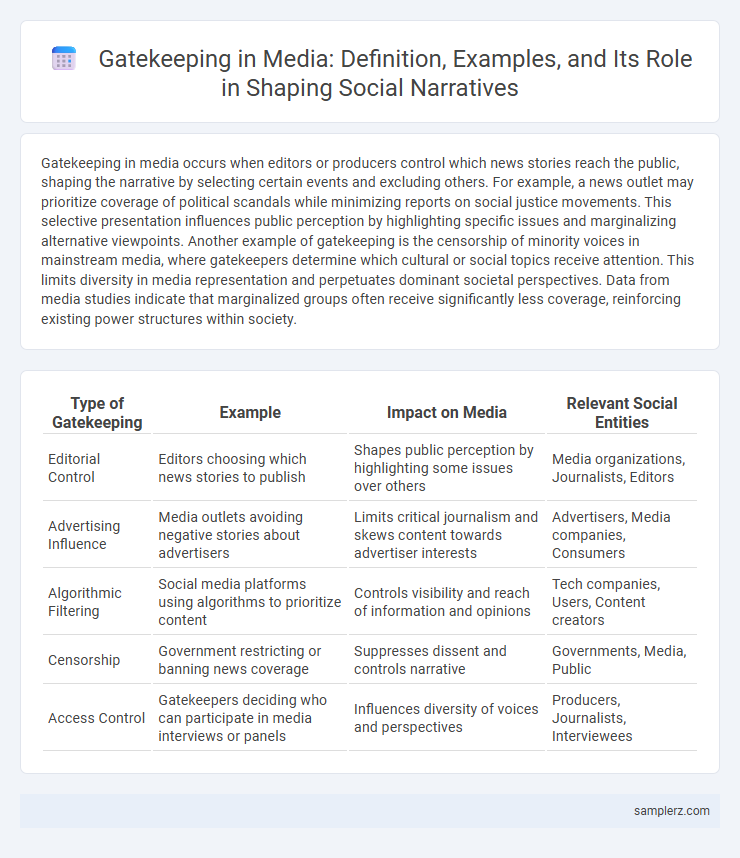Gatekeeping in media occurs when editors or producers control which news stories reach the public, shaping the narrative by selecting certain events and excluding others. For example, a news outlet may prioritize coverage of political scandals while minimizing reports on social justice movements. This selective presentation influences public perception by highlighting specific issues and marginalizing alternative viewpoints. Another example of gatekeeping is the censorship of minority voices in mainstream media, where gatekeepers determine which cultural or social topics receive attention. This limits diversity in media representation and perpetuates dominant societal perspectives. Data from media studies indicate that marginalized groups often receive significantly less coverage, reinforcing existing power structures within society.
Table of Comparison
| Type of Gatekeeping | Example | Impact on Media | Relevant Social Entities |
|---|---|---|---|
| Editorial Control | Editors choosing which news stories to publish | Shapes public perception by highlighting some issues over others | Media organizations, Journalists, Editors |
| Advertising Influence | Media outlets avoiding negative stories about advertisers | Limits critical journalism and skews content towards advertiser interests | Advertisers, Media companies, Consumers |
| Algorithmic Filtering | Social media platforms using algorithms to prioritize content | Controls visibility and reach of information and opinions | Tech companies, Users, Content creators |
| Censorship | Government restricting or banning news coverage | Suppresses dissent and controls narrative | Governments, Media, Public |
| Access Control | Gatekeepers deciding who can participate in media interviews or panels | Influences diversity of voices and perspectives | Producers, Journalists, Interviewees |
Defining Gatekeeping in Social Media
Gatekeeping in social media involves controlling and filtering the flow of information by platforms, algorithms, and content moderators, shaping what users see and engage with. This process influences public opinion by prioritizing certain voices while silencing or minimizing others, thereby affecting digital democracy and information diversity. Algorithms play a critical role by promoting content based on engagement metrics, often reinforcing echo chambers and bias.
Historical Instances of Media Gatekeeping
Historical instances of media gatekeeping prominently include the early 20th-century newspaper monopolies, where a few media moguls controlled the flow of information, shaping public discourse. The 1950s and 1960s television networks also exercised gatekeeping by selectively broadcasting news that aligned with dominant political narratives, limiting diverse perspectives. These gatekeeping practices influenced public opinion and access to information by filtering content through specific ideological lenses.
Gatekeeping in News Reporting
Gatekeeping in news reporting occurs when editors and journalists selectively filter which stories and perspectives are published, shaping public perception and discourse. Media outlets prioritize certain topics based on editorial biases, audience interests, and political affiliations, often marginalizing minority voices and alternative viewpoints. This control over information flow influences societal understanding of events and reinforces dominant cultural narratives.
Social Media Algorithms as Modern Gatekeepers
Social media algorithms act as modern gatekeepers by selectively filtering and prioritizing content based on user behavior, engagement metrics, and platform-specific criteria. These algorithms control information flow, shaping public discourse and often reinforcing echo chambers by promoting content that aligns with users' existing beliefs. Consequently, algorithmic gatekeeping influences what news, opinions, and social narratives gain visibility, significantly impacting societal perception and discourse.
Celebrity Controversies and Controlled Narratives
Celebrity controversies often serve as prime examples of gatekeeping in media, where outlets selectively highlight or suppress information to shape public perception. Media conglomerates control narratives by emphasizing scandalous details while downplaying broader contexts or opposing viewpoints. This selective coverage manipulates audience understanding and maintains the power dynamics within celebrity culture and media industries.
Marginalized Voices and Media Exclusion
Media gatekeeping often marginalizes voices from underrepresented communities by limiting their access to mainstream platforms. This exclusion perpetuates stereotypes and erases diverse perspectives, reinforcing dominant cultural narratives. Examples include the underrepresentation of Indigenous peoples and LGBTQ+ individuals in news coverage and entertainment media.
Corporate Influence on Media Content
Corporate influence on media content manifests through selective reporting that prioritizes advertiser interests over public interest, often leading to biased news coverage. Media conglomerates may suppress stories that could harm their financial partners or parent companies, limiting the diversity of perspectives available to audiences. This gatekeeping restricts critical information and shapes public opinion by controlling the narrative to favor corporate agendas.
Fact-Checking and Information Filtering
Fact-checking organizations play a crucial role in gatekeeping by verifying the accuracy of news before it reaches the public, effectively filtering out misinformation and ensuring reliable sources dominate the discourse. Social media platforms implement algorithms that prioritize content based on user engagement, which can unintentionally filter information and create echo chambers, limiting diverse perspectives. This information filtering can reinforce biases by selectively exposing audiences to specific narratives, shaping public perception and influencing social discourse.
Gatekeeping in Crisis Coverage
Gatekeeping in crisis coverage often shapes public perception by controlling which events are reported and how they are framed. News organizations prioritize certain voices and narratives, influencing the flow of critical information during natural disasters or political unrest. This selective reporting can affect crisis response effectiveness and public awareness significantly.
Strategies to Challenge Media Gatekeeping
Challenging media gatekeeping involves promoting media literacy to empower audiences in recognizing bias and censorship. Supporting independent and alternative news sources helps diversify the flow of information, reducing reliance on mainstream outlets. Encouraging participatory journalism enables marginalized voices to bypass traditional gatekeepers and share their perspectives directly.

example of gatekeeping in media Infographic
 samplerz.com
samplerz.com